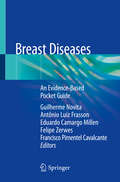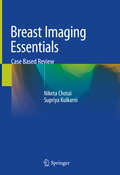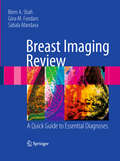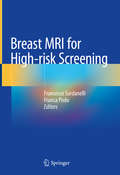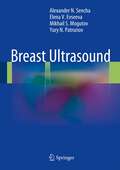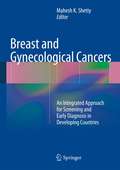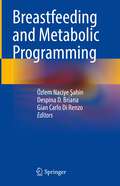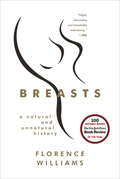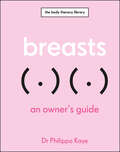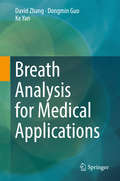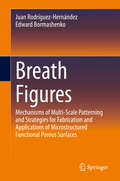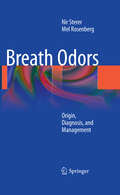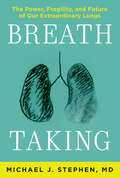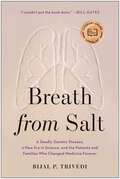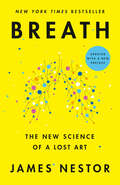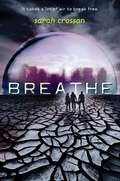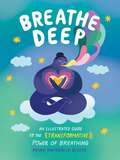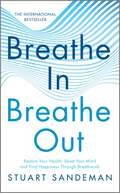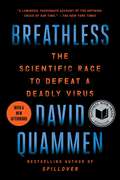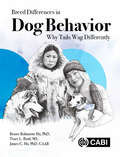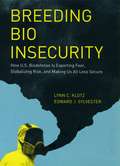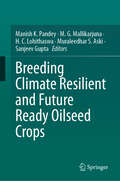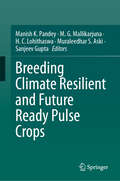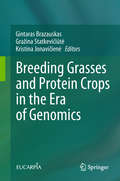- Table View
- List View
Breast Diseases: An Evidence-Based Pocket Guide
by Guilherme Novita Antônio Luiz Frasson Eduardo Camargo Millen Felipe Zerwes Francisco Pimentel CavalcanteDesigned in a small-format for practical reading and point-of-care setting use, this work presents the most up-to-date concepts on breast diseases. The main objective of this book is to propagate current knowledge of the most frequent breast diseases, being a quick reference, evidence-based manual covering the major clinical scenarios in mastology. The essence of the work can be summarized in the following sentence: "access to maximum content in the least amount of time.” The book contains data that will allow readers to understand and treat patients with different complaints and diseases. Each chapter presents a flow chart and a summary of the five major publications on the subject. This is unique in comparison with other books in this medical specialty. Developed by a team of international expert specialists who deal with breast pathologies on a daily basis, the book also includes additional contributions from experienced, renowned professionals in interdisciplinary specialties related to the main area. This book will be of interest to physicians who deal with breast diseases and wish to improve their knowledge through exposure to state-of-the-art data and best practices advice. It is also directed to medical students and residents in training within mastology.(This title was originally published in Portuguese by the Brazilian publisher Atheneu in 2011 and has sold very well and gone into a third edition, published in 2017. The Editors have all English language rights, detailed in the attached contract, although it is in Portuguese).
Breast Imaging Essentials: Case Based Review
by Niketa Chotai Supriya KulkarniThis book covers all the essential aspects of breast imaging necessary for the preparation of MMed, MD, FRCR and FRANZCR exams. The main focus is on mammogram and breast ultrasound along with basics of breast MRI and breast interventions. With the increasing popularity of these qualifying exams among radiology residents in Asia, Great Britain as well as Australia and dearth of relevant resources on the topic, this book will serve as a valuable resource for the candidates. The book is also aligned with preparations required for the FRCPC (Canada) and the American Board of Radiology. The book is divided into two sections - first section includes chapters on basics of breast imaging along with a chapter on emerging technologies while the second section includes 50 exam-relevant cases covering imaging findings utilizing appropriate BI-RADS lexicon, possible differentials, next recommended investigation and appropriate management in accordance with American College of Radiology lexicon, BI-RADS system and MRI correlation, whenever available. Readers also get familiar with the indications for breast MRI. The book is written by experts in breast imaging with relevant teaching experience. Written by an experts with strong teaching experience, this book is not only suitable for exams but is also useful for practicing breast and non-breast radiologists as well as breast care clinicians, keen to learn fundamentals of breast imaging.
Breast Imaging Review: A Quick Guide to Essential Diagnoses
by Gina Fundaro Sabala Mandava Biren ShahBreast Imaging Review: A Quick Guide to Essential Diagnoses serves as a quick review of essential radiology findings for interpreting multimodality images of the breast. The book includes 92 easy-to-read cases presenting common diagnoses, with over 360 high-quality figures encompassing mammography, ultrasound, MRI, and PET images. Also included are concise pearls covering the basics of interventional breast procedures, such as MRI-guided breast biopsy, galactography, and ultrasound-guided cyst aspirations, along with high yield facts vital to the practice of breast imaging. Co-authored by Drs. Biren A. Shah, Gina M. Fundaro, and Sabala Mandava, this book successfully integrates a comprehensive array of images, diagnoses, and discussion points into a quickly reviewable format. Breast Imaging Review is a valuable resource for radiology residents preparing to take the oral boards, as well as fellows and practicing radiologists interested in reviewing the basics of breast imaging interpretation and interventional procedures.
Breast MRI for High-risk Screening
by Francesco Sardanelli Franca PodoThis book offers a comprehensive overview of the use of breast MRI for screening high-risk women, including those with familial-genetic hereditary predisposition and previous chest radiation therapy, typically lymphoma survivors. It discusses the historical background of studies and research that provided the body of evidence in favor of MRI screening of these women. Technical and clinical topics are treated in dedicated chapters, including models for individualized risk estimation, radiogenomics of breast cancer in high-risk women, computer-aided detection/diagnosis and machine learning systems applied to breast MRI, and psycho-oncology issues. Alternatives to breast MRI screening such as pharmaco-prevention and prophylactic mastectomy are also discussed, taking into account the public debate on the “Angelina Jolie” effect. The high breast cancer risk model is proposed as a paradigm for personalized medicine. This book will be of interest to radiologists, surgeons, oncologists and to all professionals devoted to female healthcare.
Breast Ultrasound
by Alexander N. Sencha Yury N. Patrunov Mikhail S. Mogutov Elena V. EvseevaThis book is an ideal manual on the use of modern ultrasound in the diagnosis of breast pathology. It provides a comprehensive overview of current ultrasound techniques and explains the advantages and pitfalls of various ultrasound imaging modalities. Detailed attention is devoted to breast carcinoma, with guidance on differential diagnosis and presentation of pre- and postoperative ultrasound appearances. The most important benign breast diseases are also described and illustrated. Age-related features, including those seen in children and adolescents, are carefully analyzed, and an individual chapter is devoted to breast abnormalities in men. All aspects of lymph node appearances are reviewed in detail, with a special focus on the role of ultrasound in the evaluation of lymph node status. Ultrasound-guided breast interventions and imaging of breast implants are discussed in depth. This up-to-date and richly illustrated book will interest and assist specialists in ultrasound diagnostics, radiologists, oncologists, and surgeons.
Breast and Gynecological Cancers: An Integrated Approach for Screening and Early Diagnosis in Developing Countries
by Mahesh K. ShettyLow- and middle-income countries have seen a dramatic rise in the incidence of breast and gynecological cancers in the past decade. Organized cancer screening programs are not widely available in developing countries, leading to disproportionately higher mortality rates compared to those in the developed world. This book addresses cost-effective strategies for implementing programs aimed at screening for the early detection of breast, cervical, endometrial, and ovarian cancers. A well woman clinic concept providing such services as part of women's health examinations is proposed, aiming to ensure patient compliance by limiting clinic visits required for initial testing and diagnosis of screen positive cases.
Breastfeeding and Metabolic Programming
by Gian Carlo Di Renzo Özlem Naciye Şahin Despina D. BrianaThis comprehensive and updated book focuses on breastfeeding and its long-term effects which affect health and development, providing a protective metabolic programming against chronic non-communicable diseases such as diabetes, obesity, metabolic syndrome and hypertension. All recent developments of programming effects of breastfeeding are covered in chapters that provide fundamental knowledge besides update and sophisticated information on the subject. Special focus on: Metabolic programming Neuro-developmental Programming Infections This book will benefit neonatologists, pediatricians, GPs, obstetricians, endocrinologists and all health professionals interested in this quite new and developing topic. Residents and student will appreciate the contents coverage and clarity.
Breasts: A Natural and Unnatural History
by Florence WilliamsA 2012 New York Times Notable Book A 2013 Los Angeles Times Book Award Winner in the Science & Technology category An engaging narrative about an incredible, life-giving organ and its imperiled modern fate. Did you know that breast milk contains substances similar to cannabis? Or that it's sold on the Internet for 262 times the price of oil? Feted and fetishized, the breast is an evolutionary masterpiece. But in the modern world, the breast is changing. Breasts are getting bigger, arriving earlier, and attracting newfangled chemicals. Increasingly, the odds are stacked against us in the struggle with breast cancer, even among men. What makes breasts so mercurial--and so vulnerable? In this informative and highly entertaining account, intrepid science reporter Florence Williams sets out to uncover the latest scientific findings from the fields of anthropology, biology, and medicine. Her investigation follows the life cycle of the breast from puberty to pregnancy to menopause, taking her from a plastic surgeon's office where she learns about the importance of cup size in Texas to the laboratory where she discovers the presence of environmental toxins in her own breast milk. The result is a fascinating exploration of where breasts came from, where they have ended up, and what we can do to save them.
Breasts: An Owner's Guide (The\body Literacy Library)
by Philippa KayeBecome body literate with Breasts: An owner's guide, the first in an enlightening series of books that democratize health for a new generation of readers. Breasts is an informative, practical, and engaging introduction to understanding and caring for our most mythologized and objectified body part. This conversation-starting book focuses on breasts through lived experience, revealing essential things to know right now and what to expect tomorrow.Author Dr Philippa Kaye is both your GP and your friend, who believes everyone has a right to know their body. Dr Philippa tells it like it is, translating medical jargon into simple, witty prose, answering frequently asked patient queries, and investigating what we love, fear, and most misunderstand about our mammaries. Explore further: - A 10-step chapter structure to understanding and loving your breasts.- Explores the breast&’s full lifespan and applies science to the everyday.- Easy-to-follow, with simple Q&As, how-to guides, and mythbusters; plus insightful diagrams and infographics.- Newly commissioned explanatory illustrations bring fresh light to the topic.From regular self-checks and bra fitting advice, to sports, breastfeeding and what to do when things go wrong – this taboo-tackling book applies science to the everyday, with simple illustrations, checklists, FAQs, and myth busters, all supported by the latest medical research. Breasts won&’t just help you to better understand your body, it might even change your life.
Breath Analysis for Medical Applications
by David Zhang Dongmin Guo Ke YanThis book describes breath signal processing technologies and their applications in medical sample classification and diagnosis. First, it provides a comprehensive introduction to breath signal acquisition methods, based on different kinds of chemical sensors, together with the optimized selection and fusion acquisition scheme. It then presents preprocessing techniques, such as drift removing and feature extraction methods, and uses case studies to explore the classification methods. Lastly it discusses promising research directions and potential medical applications of computerized breath diagnosis. It is a valuable interdisciplinary resource for researchers, professionals and postgraduate students working in various fields, including breath diagnosis, signal processing, pattern recognition, and biometrics.
Breath Analysis: An Approach for Smart Diagnostics (Bioanalytical Reviews #4)
by Stefan WeiglThis volume highlights the potentials as well as the limits and challenges of human breath analysis and describes the current efforts made to advance this promising technology from bench to bed. Human breath analysis is a young, interdisciplinary and innovative research field aiming to provide a smart and non-invasive diagnostic tool, which can be used for screening, detecting and monitoring of diseases or metabolic disorders. This book presents different approaches for breath analysis including real-time and offline mass spectrometry as well as optical and semiconductor gas sensing methods. Besides, the role of smart algorithms to improve the performance of those technologies and the importance of pulmonary function diagnostics for more reliable and meaningful breath analysis are highlighted. Finally, current application scenarios and future perspectives of breath analysis and pulmonary functioning tests are addressed.The volume is useful for researchers, who are new in the field, to easily get an overview of the current status and the challenges present in human breath analysis. Topics from fundamental research over targeted sensor development and application scenarios are described. Thus, this volume covers all development stages providing support and inspiration for engineers, medical doctors and scientists from various fields.
Breath Figures: Mechanisms of Multi-scale Patterning and Strategies for Fabrication and Applications of Microstructured Functional Porous Surfaces
by Juan Rodríguez-Hernández Edward BormashenkoThis book offers a complete and concise overview of the different strategies used to prepare microstructured surfaces employing information regarding surface instabilities and physical processes. Based upon the concept of the remarkably uniform layer of water vapor that is applied when one simply breathes onto a surface in cold temperatures, the book presents a comprehensive treatise addressing chemical and physical fundamentals, fabrication, and applications of the breath figures approach to surface wetting, coating, and modification (breath figures self-assembly) of various materials. The main topics of the book are divided into six parts: the control of surface properties in polymer blends; block copolymer design with the aim of providing order at different lengths; combination of block copolymer blends with the breath figures (BFs); dynamic templating; the breath figures method; biorecognition; and alternative approaches for surface structuring and functionalization.Discusses various physical processing methods in preparing microstructured surfaces;Describes relevant aspects of micro- and nanostructured surfaces from fabrication to final applications, including additive manufacturing, bacterial adhesion and entrapment, optical and electro-optical applications, and membrane technology; Details the breath figures approach to surface structuring while discussing alternative strategies that tie morphology to functionality of materials.
Breath Odors: Origin, Diagnosis, and Management
by Mel Rosenberg Nir StererBad breath is a common and embarrassing problem that everyone worries about, yet most health professionals still know little about its origins, diagnosis, and treatment. Over the past fifteen years, investigators have studied how bad breath is caused, where the odors originate, and which bacteria and gases are involved. Novel in vitro systems and measurement techniques have been proposed, and clinical studies conducted to compare new and traditional treatments. This illustrated text presents, for the first time, a comprehensive and cohesive science-based approach to bad breath, combining basic research with clinical approaches to diagnosis and treatment. All aspects of the subject are examined thoroughly and critically, including the psychological impact of breath odor and future prospects. The authors draw upon more than thirty years' combined experience in this field, both in the laboratory and as consultants to thousands of patients in Canada, the US, the UK, and elsewhere.
Breath Taking: The Power, Fragility, and Future of Our Extraordinary Lungs
by Michael J. StephenAn expert in pulmonary medicine shares a wide-ranging exploration of the human lung: the organ that explains our origins and holds the keys to our future.We take an average of 7.5 million breaths a year and some 600 million in our lifetime, and what goes on in our body each time oxygen is taken in and carbon dioxide expelled is nothing short of miraculous. “Our lungs are the lynchpin between our bodies and the outside world,” writes pulmonologist Michael Stephen. And yet, we too often take our lungs for granted.In Breath Taking, Stephen sheds much-needed light on our extraordinary lungs. He relates the history of oxygen on Earth and the evolutionary origins of breathing, and explores the healing power of breath and its spiritual potential. Stephen interweaves his narrative with scientific history, such as the development of the lung transplant, and poignant human stories, including his own frantic attempts to engage his son’s lungs at birth.Despite great advances in science, our lungs are ever more threatened. Asthma is on the rise, increasing anxiety leaves us vulnerable to disease, and COVID-19 has revealed that vulnerability in historic ways. Breath Taking offers inspiration and hope, inspiration, and vital perspective to us all.
Breath from Salt: A Deadly Genetic Disease, a New Era in Science, and the Patients and Families Who Changed Medicine Forever
by Bijal P. TrivediRecommended by Bill Gates and included in GatesNotes "Elaborating on the science as well as the business behind the fight against cystic fibrosis, Trivedi captures the emotions of the families, doctors, and scientists involved in the clinical trials and their 'weeping with joy' as new drugs are approved, and shows how cystic fibrosis, once a 'death sentence,' became, for many, a manageable condition. This is a rewarding and challenging work." —Publishers Weekly Cystic fibrosis was once a mysterious disease that killed infants and children. Now it could be the key to healing millions with genetic diseases of every type—from Alzheimer's and Parkinson's to diabetes and sickle cell anemia. In 1974, Joey O'Donnell was born with strange symptoms. His insatiable appetite, incessant vomiting, and a relentless cough—which shook his tiny, fragile body and made it difficult to draw breath—confounded doctors and caused his parents agonizing, sleepless nights. After six sickly months, his salty skin provided the critical clue: he was one of thousands of Americans with cystic fibrosis, an inherited lung disorder that would most likely kill him before his first birthday. The gene and mutation responsible for CF were found in 1989—discoveries that promised to lead to a cure for kids like Joey. But treatments unexpectedly failed and CF was deemed incurable. It was only after the Cystic Fibrosis Foundation, a grassroots organization founded by parents, formed an unprecedented partnership with a fledgling biotech company that transformative leaps in drug development were harnessed to produce groundbreaking new treatments: pills that could fix the crippled protein at the root of this deadly disease. From science writer Bijal P. Trivedi, Breath from Salt chronicles the riveting saga of cystic fibrosis, from its ancient origins to its identification in the dank autopsy room of a hospital basement, and from the CF gene's celebrated status as one of the first human disease genes ever discovered to the groundbreaking targeted genetic therapies that now promise to cure it. Told from the perspectives of the patients, families, physicians, scientists, and philanthropists fighting on the front lines, Breath from Salt is a remarkable story of unlikely scientific and medical firsts, of setbacks and successes, and of people who refused to give up hope—and a fascinating peek into the future of genetics and medicine.
Breath: The New Science of a Lost Art
by James NestorNo matter what you eat, how much you exercise, how skinny or young or wise you are, none of it matters if you&’re not breathing properly.There is nothing more essential to our health and well-being than breathing: take air in, let it out, repeat 25,000 times a day. Yet, as a species, humans have lost the ability to breathe correctly, with grave consequences. Journalist James Nestor travels the world to figure out what went wrong and how to fix it. The answers aren&’t found in pulmonology labs, as we might expect, but in the muddy digs of ancient burial sites, secret Soviet facilities, New Jersey choir schools, and the smoggy streets of São Paulo. Nestor tracks down men and women exploring the hidden science behind ancient breathing practices like Pranayama, Sudarshan Kriya, and Tummo and teams up with pulmonary tinkerers to scientifically test long-held beliefs about how we breathe. Modern research is showing us that making even slight adjustments to the way we inhale and exhale can jump-start athletic performance; rejuvenate internal organs; halt snoring, asthma, and autoimmune disease; and even straighten scoliotic spines. None of this should be possible, and yet it is. Drawing on thousands of years of medical texts and recent cutting-edge studies in pulmonology, psychology, biochemistry, and human physiology, Breath turns the conventional wisdom of what we thought we knew about our most basic biological function on its head. You will never breathe the same again.
Breathe
by Sarah CrossanInhale. Exhale. Breathe. Breathe. Breathe . . . The world is dead. The survivors live under the protection of Breathe, the corporation that found a way to manufacture oxygen-rich air. Alina has been stealing for a long time. She's a little jittery, but not terrified. All she knows is that she's never been caught before. If she's careful, it'll be easy. If she's careful. Quinn should be worried about Alina and a bit afraid for himself, too, but even though this is dangerous, it's also the most interesting thing to happen to him in ages. It isn't every day that the girl of your dreams asks you to rescue her. Bea wants to tell him that none of this is fair; they'd planned a trip together, the two of them, and she'd hoped he'd discover her out here, not another girl. And as they walk into the Outlands with two days' worth of oxygen in their tanks, everything they believe will be shattered. Will they be able to make it back? Will they want to?
Breathe Deep: An Illustrated Guide to the Transformative Power of Breathing
by Misha Maynerick BlaiseTake a deep breath and get lost in this illustrated guide to the transformative power of breathing combining inspiration, instruction, and amazing illustrations to create a one-of-a-kind book about the popular practice of breath work.Breathing happens. All day long you are sustained by the movement of air in and out of your lungs. Because it&’s a natural function most people don&’t give much thought to it. But when you consciously engage your breath, incredible things can happen. Filled with vibrant art, meaningful quotes, practical exercises, and lighthearted humor, Breathe Deep stokes the curious mind and inspires a deeper relationship with the power of breath. Drawing upon both ancient wisdom and cutting-edge science, Breathe Deep delves into the mechanics of respiration and the proven physical and emotional benefits of conscious breathing. As a bridge that unites body and mind, breath work is a powerful tool that can be used to calm anxiety and transform limiting mindsets.
Breathe In, Breathe Out: Restore Your Health, Reset Your Mind and Find Happiness Through Breathwork
by Stuart SandemanTHE INTERNATIONAL BESTSELLERIt&’s time to get your breath back.Since tragic loss brought him to breathwork, Stuart Sandeman has helped thousands of people transform their lives, simply by changing the way they breathe.In Breathe In, Breathe Out, Stuart takes you on a journey to discover a hidden power within you that can change the way you think and feel. His accessible exercises, grounded in research and developed over years of practice, will help you to: Sleep soundly and manage stress and pain. Identify and let go of the beliefs that are holding you back. Develop better focus and boost your performance in any field. Deepen the connection with yourself, others and the world around you.You can become stronger, healthier and happier than you've ever imagined. All you have to do is Breathe In, Breathe Out.
Breathless: The Scientific Race to Defeat a Deadly Virus
by David QuammenNational Book Award finalist Breathless tells the story of the worldwide scientific race to decipher the coronavirus SARS-CoV-2, trace its source, and make possible the vaccines to fight the Covid-19 pandemic—a &“luminous, passionate account of the defining crisis of our time.&” (The New York Times).Breathless is a &“gripping&” (The Atlantic) but &“clear-eyed analysis&” (Time) of SARs-CoV-2 and its fierce journey through the human population, as seen by the scientists who study its origin, its ever-changing nature, and its capacity to kill us. David Quammen expertly shows how strange new viruses emerge from animals into humans as we disrupt wild ecosystems and how those viruses adapt to their human hosts, sometimes causing global catastrophe. He explains why this coronavirus will probably be a &“forever virus,&” destined to circulate among humans and bedevil us endlessly, in one variant form or another. As scientists labor to catch it, comprehend it, and control it, with their high-tech tools and methods, the virus finds ways of escape. Based on interviews with nearly one hundred scientists, including leading virologists in China and around the world, Quammen explains that: -Infectious disease experts saw this pandemic coming -Some scientists, for more than two decades, warned that &“the next big one&” would be caused by a changeable new virus—very possibly a coronavirus—but such warnings were ignored for political or economic reasons -The precise origins of this virus may not be known for years, but some clues are compelling, and some suppositions can be dismissed -And much more Written by &“one of our finest explainers of the natural world for decades&” (Chicago Tribune), This &“compelling and terrifying&” (The New York Times) account is an unparalleled look inside the frantic international race to understand and control SARS-CoV-2—and what it might mean for the next potential global health crisis.
Breed Differences in Dog Behavior: Why Tails Wag Differently
by Dr Renee R. Ha Tracy L. Brad Dr James C. HaHumans have bred dogs for physical and behavioral characteristics for millennia. These efforts can have unintended side effects, however, which may be either advantageous or cause issues - such as a predisposition to certain medical complaints, or, controversially, behavioural issues. The scientific study of domestic dogs is still in its infancy, but public demand for this information is at a record high as more and more pet owners seek to understand their canine family members. Focusing on the behavioral differences and tendencies that have arisen in different breed lines, this book explores, summarizes, and explains the scientific evidence on what breed can tell us about behaviour - and, crucially, what it cannot. This book covers: - the impact of inbreeding, how it contributes to problematic behavioral issues such as anxiety and aggression, and how it potentially affects the future health of the breed; - the limits of predicting a dog's behavior based upon breed, individual differences within breeds, and thus the corresponding limitations of breed-specific legislation; - guidance for professionals to help their clients better understand behavioral issues, traits, and appropriate expectations around the right breed for their household. Providing a comprehensive and approachable view of the science behind breed-specific behaviors, this book gives dog enthusiasts from all professional and personal backgrounds a better understanding of why dogs do what they do, and how we can improve our relationships with our canine companions. Covering genetics, phylogeny of canids, temperament, aggression, social behavior, and the history of dog breeding, it is an important read for researchers, students, veterinary practitioners and animal behaviourists, as well as shelter staff, dog trainers, or anyone looking for a greater understanding of dog breed differences.
Breeding Bio Insecurity: How U. S. Biodefense Is Exporting Fear, Globalizing Risk, and Making Us All Less Secure
by Lynn C. Klotz Edward J. SylvesterForceful and provocative, Breeding Bio Insecurity contends that U.S. bio defense policies generate more risk than the threat they are supposed to be addressing. By carefully spelling out their rationales, the book's authors place the burden of justification on the defenders of massive bio defense budgets. Replete with deft arguments and imaginative scenarios, this book should be read by scientists, policy makers and, indeed, all concerned citizens.
Breeding Climate Resilient and Future Ready Oilseed Crops
by Sanjeev Gupta Manish K. Pandey M. G. Mallikarjuna H. C. Lohithaswa Muraleedhar S. AskiThis edited book covers the application of modern genomics tools for developing climate-smart oilseed cultivars. The book's prime focus is on utilizing available oilseed genomic resources and application of next-generation genetics and breeding tools, viz. genome-wise association mapping, genomic selection, genome editing and accelerated breeding pipelines and their efficacy for rapid development and delivery of stress-resilient oilseeds cultivars. Oilseeds are crucial for human and animal nutrition and cater to diverse industrial applications. Besides oil content, the oilseed meal possesses proteins and a higher proportion of essential amino acids, which benefit human well-being. Additionally, the contribution of oilseeds towards renewable energy mitigates the risk of climate change by reducing carbon footprint. Hence, it is imperative to enhance oilseeds production from the current 178 to 282 million tons by 2050 to meet the demands of both the population and the environment. The current genomics era delivered various genomic resources in oilseed crops, which resulted in the discovery of genes for several agronomic and stress-resilience traits and resistance to pests and diseases. Further, the availability of next-generation plant breeding tools, such as genomic selection, genome editing, and speed breeding, are being implemented along with traditional and marked assisted selection. Thus, the book is framed to compile the importance and utility of next-generation breeding tools for enhancing stress resilience in oilseed crops in the climate change era. The book is exciting and valuable to national and international agricultural scientists, scholars and graduate students associated with oilseed crops improvement in specific and field crops in generic. The book also serves as reference in formulating various oilseed improvement programs for policymakers and research grant managers.
Breeding Climate Resilient and Future Ready Pulse Crops
by Sanjeev Gupta Manish K. Pandey M. G. Mallikarjuna H. C. Lohithaswa Muraleedhar S. AskiThis edited volume covers the application of modern breeding tools for developing climate-smart pulse crop cultivars. The primary focus is on utilizing available genomic resources and next-generation breeding technologies such as genome-wide association mapping, genomic selection, genome editing, and accelerated breeding pipelines for the rapid development of stress-resilient, systems-specific pulse cultivars. Pulses contribute to 10% of global daily protein intake and 5% of energy. Their ability to fix atmospheric nitrogen and serve as an alternative protein source to meat makes them crucial in combating global warming. With the global population expected to reach 9.8 billion by 2050, pulses production needs to increase by at least 70% to meet demand. However, pulses production is facing growing biotic and abiotic challenges, exacerbated by climate change. Thus, developing next-generation climate-smart cultivars is essential to ensure food and nutritional security. Recent efforts by global and national breeding communities have led to the discovery of new genomic resources, shifting breeding from phenotype-based to genome-based approaches. These advances integrate rapid generation advancement pipelines with genomic-assisted breeding, trait mapping, and genome editing tools. This book is valuable for agricultural scientists, scholars, and graduate students involved in pulse crop improvement. It also serves as a reference for policymakers and research grant managers in formulating pulse research programs.
Breeding Grasses and Protein Crops in the Era of Genomics
by Gintaras Brazauskas Gražina Statkevičiūtė Kristina JonavičienėThis book includes papers presented at the 2017 Joint meeting of Fodder Crops and Amenity Grasses Section and Protein Crops Working Group of EUCARPIA-Oil and Protein Crops Section. The theme of the meeting “Breeding Grasses and Protein Crops in the Era of Genomics” has been divided into six parts: (1) Utilisation of genetic resources and pre-breeding, (2) Genetic improvement of quality and agronomic traits, (3) Breeding for enhanced stress tolerance (4) Implementation of phenomics and biometrics, (5) Development of genomic tools and bioinformatics and (6) Reports of Parallel Sessions.
